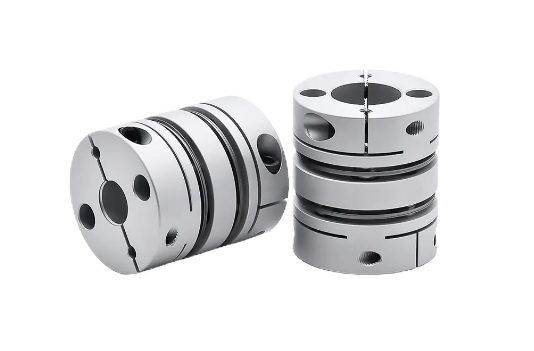Understanding Diaphragm Coupling Mechanics
How Diaphragm Couplings Transmit Torque
Diaphragm couplings play a crucial role in torque transmission by employing a flexible diaphragm to handle misalignments and thermal expansion. This unique capability comes from the diaphragm's ability to bend, allowing it to accommodate variable loads while ensuring efficient torque transfer. Unlike conventional coupling types, diaphragm couplings can manage higher torque and speed demands, making them ideal for high-performance applications. Engineering studies highlight their superior performance, as they often outshine traditional couplings in challenging environments, offering significant advancements in system efficiency.
Advantages Over Gear and Grid Couplings
Diaphragm couplings offer several advantages over gear and grid couplings, primarily due to their simpler design with fewer moving parts. This simplicity translates to lower maintenance requirements and enhanced reliability. Furthermore, diaphragm couplings excel in minimizing backlash and wear, making them particularly beneficial for precision applications where accuracy and consistency are critical. Industry surveys suggest that these couplings significantly reduce vibrations, thereby prolonging machinery life and reducing downtime. As a result, they are increasingly favored in scenarios where equipment availability and longevity are paramount.
Key Factors for Optimal Diaphragm Coupling Selection
Assessing Torque Capacity and RPM Limits
Understanding the specific torque capacity and RPM limits is crucial when selecting a diaphragm coupling to ensure it performs as expected under load conditions. Diaphragm couplings are often preferred for their high torque transmission capabilities without increasing the overall size, making them ideal for high-speed machinery applications. Ensuring the selected coupling meets the required torque capacity can prevent mechanical failures and extend the lifespan of the system. According to industry standards, exceeding the torque rating of a diaphragm coupling can lead to catastrophic failures, emphasizing the necessity of adhering to manufacturer specifications. Similarly, unfamiliarity with RPM limits can result in operational inefficiency and potential equipment damage. Thus, thorough assessment of these parameters is imperative for optimal selection.
Evaluating Angular, Parallel, and Axial Misalignment Tolerance
Evaluating the misalignment tolerance of diaphragm couplings is essential for ensuring mechanical performance and longevity. Typically, these couplings exhibit superior tolerance to angular and parallel misalignments compared to rigid couplings, allowing for greater flexibility during installation. This flexibility is achieved through the couplings' ability to compensate for discrepancies in alignment, ensuring smooth operation across various conditions. Research underscores that accurately assessing misalignment parameters can drastically reduce failure incidents, making proper evaluation imperative. By considering these factors, businesses can enhance their equipment's operational efficiency and reduce maintenance costs in the long run.
Material Selection for Corrosion and Temperature Resistance
Choosing appropriate materials for diaphragm couplings is critical, especially in environments prone to corrosion or extreme temperatures. Materials such as stainless steel or specialized alloys enhance durability and provide better performance in challenging conditions. Industry guidelines reveal that using corrosion-resistant materials significantly increases coupling reliability, ensuring operational integrity in adverse conditions. This selection becomes particularly crucial when deploying couplings in high-temperature settings, where material degradation could otherwise compromise functionality. Therefore, careful consideration of material properties contributes to the longevity and efficiency of the coupling in various industrial applications.
Application-Specific Performance Considerations
High-Speed Machinery Requirements
Diaphragm couplings are engineered to excel in high-speed machinery applications, where rotor dynamics and balance are critical. These couplings are specifically designed to manage high rotational speeds while maintaining stability and precision. For instance, they are commonly used in compressors and turbine drives, known for their operational challenges that demand robust solutions. Selecting the right diaphragm coupling can mitigate risks such as excessive vibration and operational inefficiency, which are prevalent in high-speed environments. Studies indicate that mismatched couplings can lead to increased wear and potential system failures, emphasizing the importance of precise selection. This minimizes risks of mechanical breakdown and enhances the lifespan of the equipment, providing reliable performance in demanding settings.
Handling Shock Loads in Turbine and Pump Systems
Diaphragm couplings are particularly adept at managing shock loads, which makes them ideal for turbine and pump systems where load variations are frequent. These couplings are designed to rapidly transfer loads, thereby minimizing stress on connected components. Their ability to reduce mechanical stress is due to the shock-absorbing characteristics inherent in their design. For example, in turbine and pump applications, where sudden changes in load are more likely to occur, diaphragm couplings act as a buffer, effectively absorbing energy spikes and protecting equipment from potential damage. Engineering studies support that diaphragm couplings' capacity to absorb shock loads significantly reduces the risk of mechanical failures. This robustness ensures smooth and uninterrupted operation of critical systems, safeguarding against unexpected downtimes and maintenance costs.
Installation and Maintenance Best Practices
Proper Alignment Techniques to Prevent Premature Wear
Proper alignment is crucial for prolonging the life of diaphragm couplings and preventing premature wear. Misalignment can result in excessive vibration and operational inefficiencies, which, in turn, lead to costly repairs and downtime. Techniques such as laser alignment offer significant advantages by ensuring precise setup, minimizing the risk of installation errors. These systems provide high accuracy, which is critical in achieving optimal performance and extending the lifespan of mechanical components. To maintain these benefits, experts recommend regular alignment checks, which help in identifying potential issues early and reducing maintenance costs.
Lubrication-Free Operation and Inspection Intervals
One of the key advantages of diaphragm couplings is their lubrication-free operation. This design feature significantly reduces the burden of regular maintenance tasks and associated costs. However, it is essential to establish proper inspection intervals to ensure that the couplings continue to perform optimally. Regular inspections can help identify wear and potential issues before they lead to operational failures, thereby preventing costly downtime. Best practices suggest scheduling these inspections at intervals based on operational conditions and load demands, ensuring prolonged reliability and efficiency of the coupling systems.
FAQ Section
What is a diaphragm coupling?
A diaphragm coupling is a type of flexible coupling that utilizes a diaphragm to transmit torque, accommodate misalignments, and manage thermal expansion, offering high-performance capabilities.
What are the advantages of diaphragm couplings over gear and grid couplings?
Diaphragm couplings provide advantages such as simpler design, reduced maintenance, enhanced reliability, minimized backlash, and superior vibration reduction.
How does material selection impact diaphragm coupling performance?
The choice of materials, like stainless steel or specialized alloys, impacts performance by enhancing durability and resistance to corrosion and high temperatures, ensuring long-term reliability.
Why is proper alignment important for diaphragm couplings?
Proper alignment ensures optimal performance, prevents premature wear, reduces vibration, and avoids costly repairs due to misalignment errors.
How often should diaphragm couplings be inspected?
Inspection intervals should be based on operational conditions and load demands to identify issues early and ensure the coupling's prolonged efficiency and reliability.

